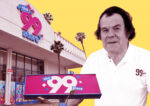Short sellers are betting against SL Green
Investors hold short positions on 15.5% of REIT’s shares — and climbing

In the immortal words of Kermit the Frog, “It’s not easy bein’ green.”
While the Muppet star was specifically lamenting his verdant complexion, his lyrics may now apply to New York City’s largest commercial landlord too.
Marc Holliday and Andrew Mathias’ SL Green Realty is feeling it from shareholders. Investors held short positions on 15.5 percent of the REIT’s publicly tradable shares as of Feb. 28, the most recent numbers available, according to MarketBeat. That’s up from 12 percent on Dec. 30, 10.6 percent at the end of August and 9.5 percent a year ago.
Investors often show pessimism about a company’s future by taking short positions on its stock, allowing them to profit as the share price declines. When the portion of a company’s publicly traded shares, or float, that is held by short sellers rises above 10 percent, it typically signifies that the market is bearish on its future. Above 20 percent, it’s considered a highly shorted stock.
The rise in SL Green’s short interest comes as its share price has plummeted 65 percent in the past year, closing Tuesday at an even $28. It was trading at around $80 this time last year, and it started 2023 above $34.
SL Green is far from the only publicly traded office landlord that has drawn gloomy outlooks from investors as demand for office space remains tepid, interest rates remain high and loan maturities loom. But its peers have not drawn the same level of interest from short sellers.
Both Empire State Realty Trust and Vornado Realty Trust have seen investors hold short positions on more than 10 percent of their publicly tradable shares in recent months, but both now sit below the double-digit threshold. Paramount Group, whose portfolio is split between New York and San Francisco, an even more beleaguered office market, has just 2.9 percent of its stock in the hands of short sellers.
So why is Wall Street betting against SL Green? According to veteran REIT analyst John Kim, with BMO Capital Markets, it’s all about debt.
Though it boasts a premium portfolio including some of the city’s priciest office space at One Vanderbilt, SL Green is more highly leveraged than the likes of ESRT and Vornado, Kim said. The REIT also has a fair amount of interest rate swaps that expire within the next two years.
“So as we get into this higher-rate environment, it just makes refinancing that much more expensive,” Kim said.
Kim also pointed to two deals last fall, SL Green’s takeover of 245 Park Avenue and its debt-to-equity swap at RXR Realty’s 5 Times Square, as highly leveraged assets with a lot of leasing risk in the short-term.
SL Green managed to backfill most of the space vacated by Major League Baseball at 245 Park Avenue with short-term deals that will expire in the next one to three years, executive Steve Durels said on the REIT’s fourth-quarter earnings call in January. About 800,000 square feet at the building will roll over in the next 36 months, Durels said.
As interest rates rose last year, Holliday said SL Green’s “number one priority” was reducing its debts and hedging against rate increases.
“We’re a little higher [leveraged] than typical right now because of some asset acquisitions we did, and so that’s part of the reason we're targeting debt repayment over the course of this year,” DiLiberto reiterated on the January call. “But where we were prior to that and where we'll be at the end of this year based on the plan we have in place, we are completely comfortable with.”
SL Green has previously bought back its stock when it felt its shares were undervalued, but paused its buyback program last year. Repurchasing shares now would be counterintuitive to reducing leverage, Kim said.
“It’s a little bit circular,” Kim said. “Theoretically, if they didn’t have the balance sheet issue, then buying back shares would support the share price and it would work as an instrument against shorting the stock. The more you do that for [SL Green] or any highly leveraged company, buying back shares would just make the issue worse because they’re just adding leverage.”
What will help clean up SL Green’s balance sheet is its plan to sell off more than $2 billion in assets this year. The company had about $5.4 billion in total debt at the end of December.
The bulk of that disposition plan could be achieved by selling its roughly 75 percent stake in 245 Park Avenue to a private capital partner who can help finance the firm’s redevelopment of the 44-story, 1.8-million-square-foot office tower into another trophy office building like One Vanderbilt or One Madison.
Read more
The REIT said on its fourth-quarter earnings call that it’s already garnering interest from foreign investors and potential tenants for the project and that it hopes to identify one or more joint-venture partners this year.
“If that happens, that helps a lot,” Kim said. “It doesn’t solve all their issues, but it would be a significant amount of debt that comes off their books and de-risks the development.”
SL Green did not respond to a request for comment.







